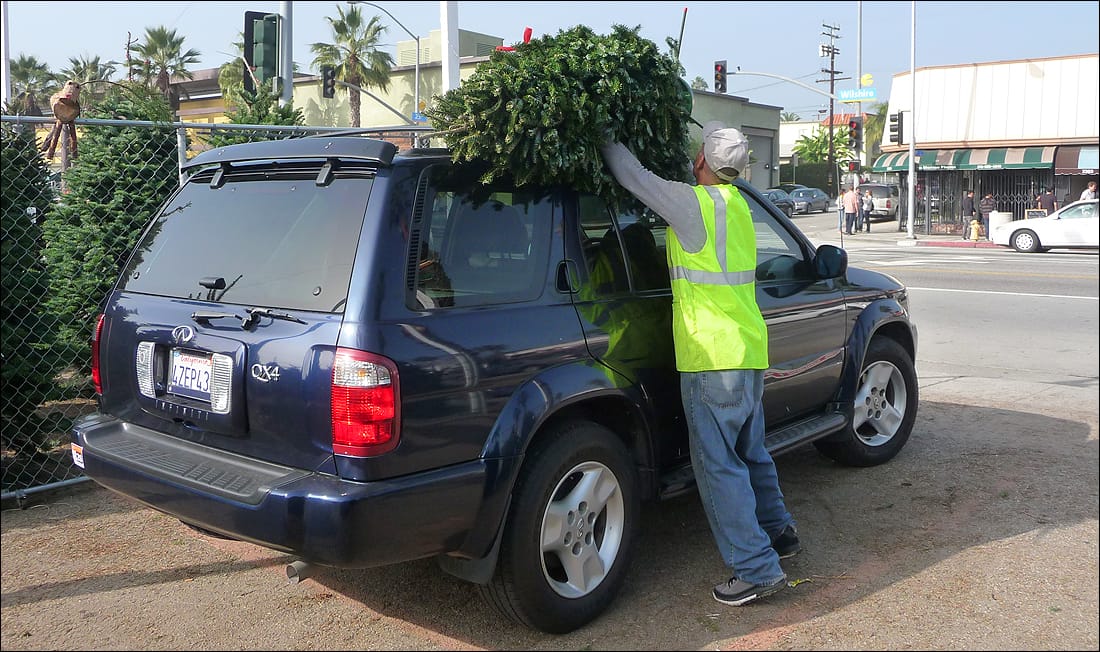
CITYWIDE — Real or fake?
It's a popular question in Los Angeles, but at this time of year it's directed at only one kind of ornamentation — Christmas trees.
The debate between real conifers and artificial trees reopens every year after the last of the Thanksgiving turkey leaves the table and before the marathon of "It's a Wonderful Life" begins.
Those on the side of fresh trees hold that the once-living specimens are a critical component of the holidays — the experience of selecting a pine, the smell of it in the home and even the way the needles get absolutely everywhere are hallmarks of the season.
Fake tree proponents note the convenience of the up-cycled PVC pipe and the fact that it spares those with allergies and ducks the doom of "Christmas tree syndrome," a respiratory illness caused by mold that grows on the trees.
While each has checks in the "pro" column, both try to lay claim to the one with the most value in sustainable Santa Monica — the environmental seal of approval.
If you ask Rick Dungey, public relations manager for the National Christmas Tree Association, there is no contest.
"The only people still out about this are the people who sell plastic trees," Dungey said.
Although people question the ecology of cutting down living trees for Christmas decoration, the life cycle of a tree can be up to six years before it ends up in a lot, providing something that artificial trees cannot — carbon absorption.
"The plastic, tree-shaped decorations say ‘save a tree and buy a plastic tree instead,' which I think is completely duplicitous," Dungey said.
The trees also travel less than their plastic cousins.
Shawn Wilk — who runs Shawn's Christmas Tree lot at 23rd Street and Wilshire Boulevard with his wife, Eliane — gets his trees from California's northern neighbor, Oregon. He even travels there in August or October to select the trees that will later appear in homes across the Westside.
Plastic trees, on the other hand, are assembled in factories in China out of metal and PVC pipe, the same material that is used in plumbing. According to a study by the Canadian firm Ellipsos, it would take 20 years of reuse before a plastic tree was a superior choice in terms of climate change.
"Where do the materials come from? I can tell you where a real tree comes from — a pine cone," Dungey said.
Real trees aren't just green — Dungey will tell you they're natural medicine.
A study conducted in Japan showed that people who spent time in a pine forest were less hostile and depressed, in general reporting a reduction in painful emotions.
It's unclear if that can be extrapolated to the presence of a single Christmas tree in the home, but those in search of a real tree certainly seem to see the salutary benefits.
For Karen Thorland, it's the smell. Thorland was tree-shopping early Sunday morning, seeking out a Douglas fir, the species that best holds up her ornaments. Although a plastic tree would serve the same purpose, the genuine article has intangibles that cannot be replicated, she said.
"I like the smell," Thorland said. "I save part of it every year and burn it, like a Yule log."
Those on the side of plastic have a study of their own.
A report by PE Americas shows that although a plastic tree takes up three times the resources of a natural tree if it's only used once, that changes rapidly. Over the course of five years a natural tree is one and a half times as much. In a decade, natural trees require three times the resources. The calculations assume both trees end up in a landfill.
On average, Americans keep plastic trees for six years, according to the Ellipsos study.
Artificial trees are often maligned for their environmental impact, but the PE Americas study shows that it's unfair, said Jamie Warner, executive director of the American Christmas Tree Association, a group that promotes Christmas trees of all kinds.
One drawback of false trees is the inability to recycle them, which means the trees end up as landfill fodder, unlike their pine counterparts which find another life after the season ends.
The industry is in search of ways to improve on that score, and a method of recycling the trees may be around the corner, Warner said.
Until then, people are finding creative uses for retired artificial Christmas trees.
"Hunters are using them and recycling them as blinds," Warner said.
Alison Kmetko sees all of the upsides of the artificial trees. She used one for years, but was considering a change, which is why she and her high school friend Lois Davis were out at Shawn's Christmas Trees lot Sunday morning.
Real trees smell better, but are an awful lot of work if you don't have children to rope into the set up process, and that kind of Christmas tradition is really meant for the young she said.
Those factors combined, Kmetko was considering leaving artificial trees and their natural, cut brethren for a third, ultimately greenest option: a living tree.
It's hard to argue with that.
ashley@www.smdp.com

